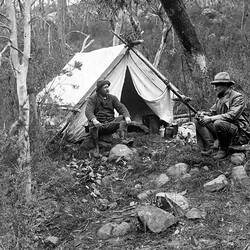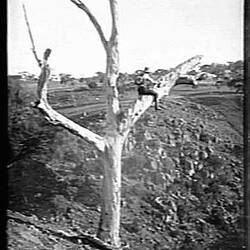Boobook Owl
Geographical Distribution - Australia and Tasmania, also Lord Howe Island.
Nest - Usually a hollow spout or limb of a tree, dead or living, the eggs being deposited on the decayed wood-dust within.
Eggs - Clutch, three, occasionally four; nearly round, compressed slightly at one end; texture somewhat coarse, with a few limy excresences on the surface which is slightly glossy and very minutely pitted; colour, white. Dimensions in inches of a proper clutch: (1) 1.79 x 1.45, (2) 1.72 x 1.43, (3) 1.71 x 1.45.
Observations - The Boobook Owl is a rusty-coloured bird irregularly blotched with white. This nocturnal creature is undoubtedly the most common Owl in Australia., having been recorded from every district, and go where you will amongst timber you are almost sure to hear the familiar "mo-poke," or, as the aboriginals more correctly imitate the bird's call, "book-book," or "buck-buck." I have heard it in the Dandenongs commence to call usually about three-quarters of an hour after sunset.
Great has been the controversy whether this Owl or the Tawny-shouldered Frogmouth (Podargus) is in reality called the 'Mo-poke.' As far as I am concerned, it was settled long ago. One night we heard the unmistakable call repeatedly from a tall tree. Stealing up quietly, and having located the exact spot of the sound, a shot from one of our guns brought down a Boobook Owl. Moreover, in later years, during some of the pleasant camp-outs of a few enthusiastic field naturalists, we had additional proof as to the Owl calling 'mo-poke.' One of our members, who seemed possessed of a phenomenal throat, could imitate to the very sound the Boobook Owl, and when he could catch the bird's ear in the forest, by imitating it could always bring a bird into the tree overhead. I remember on one occasion we had a new member out with us who was anxious to procure a skin of the Owl. During the evening, our friend with the phenomenal throat got behind a tree at the rear of our tent and cleverly produced the Owl's call. 'Great Scot!' said our new member, 'a Boobook!' and seizing his gun rushed out of the tent. He continued to gaze up the tree where the supposed Owl was, till shouts of derisive laughter caused him to return.
On the morning of the 11th of October, 1890, three of us were hastening over the she-oak (Casuarina) clad hills near Myrniong, on the Upper Werribee, Victoria, when one of us casually threw a stone against the limb. Then followed expeditiously the natural sequence - a climb, the chopping of a hole in the tough weather-beaten limb, and a clutch of three eggs is added to our collection. The situation of the eggs was about fifteen feet from the ground.
The original eggs Gould described were taken on the 8th November, by his useful aboriginal companion, 'Natty.' The specimens were in a forward state of incubation. Mr. Wm. White (Adelaide), on two occasions on Kangaroo Island took four eggs of the Boobook Owl from deserted Ravens' nests. A curious place indeed for an Owl to deposit her eggs.
The Boobook Owl can fly by day as well as by night; but it is not generally known that it sometimes takes its prey by day - at all events, in the subdued daylight of a thick forest. On one occasion Mr. G. A. Keartland, about two o'clock in the afternoon, in the Dandenongs, shot a Boobook in the act of devouring something which proved to be a freshly- captured Pilot Bird (Pycnoptilus).
The usual breeding months are October, November, and December.
Resources
Transcribed Archibald James Campbell. Nests and Eggs of Australian Birds, including the Geographical Distribution of the Species and Popular Observations Thereon, Pawson & Brailsford, Sheffield, England, 1900, p.43.
More Information
-
Keywords
-
Authors
-
Contributors
-
Article types
![[Raiding the nest of a Boobook Owl in a hollow tree, Werribee, about 1900.]](/content/media/16/53216-small.jpg)

